Refuel once please! (english below)
Der Rauchende Teufel -oh Wunder- hatte zwar schon Tanks für Öl und Sprit, allerdings sagte uns das nicht so ganz zu. Optisch und technisch. Also mal überlegt wie man die Tanks bauen könnte. Die erste Wahl, nämlich 2mm Aluminiumblech fiel schnell aus. Was für Öl noch in Ordnung wäre, ginge für Methanol nicht lange gut. Alu und Alkohol mögen sich nicht wirklich. Resultat ist ein breiig körniger Gubbel der alles verstopft…
An dieser Stelle auch vielen Dank an den Input den ich im deutschen Traktorpullingforum bekommen habe.
So soll er nun aus Edelstahl….genauer aus Edelstahl rostfrei werden. *klugscheiß*
Er? Sie! Es werden nämlich zwei gleiche….ja OK…spiegelverkehrte gebaut.
Fangen wir an.
The Smoking Devil – oh wonder – already had tanks for oil and fuel, but that didn’t really appeal to us. Visually and technically. So think about how you could build the tanks. The first choice, namely 2mm aluminum sheet, fell out quickly. What would still be okay for oil would not be good for methanol for long. Aluminum and alcohol don’t really like each other. The result is a pulpy granular gub that clogs everything …
At this point, many thanks to the input I received in the German tractor pulling forum.
So it should now be made of stainless steel.
It? Them! There are namely two identical …. yes OK … built mirror-inverted.
Let’s get started.
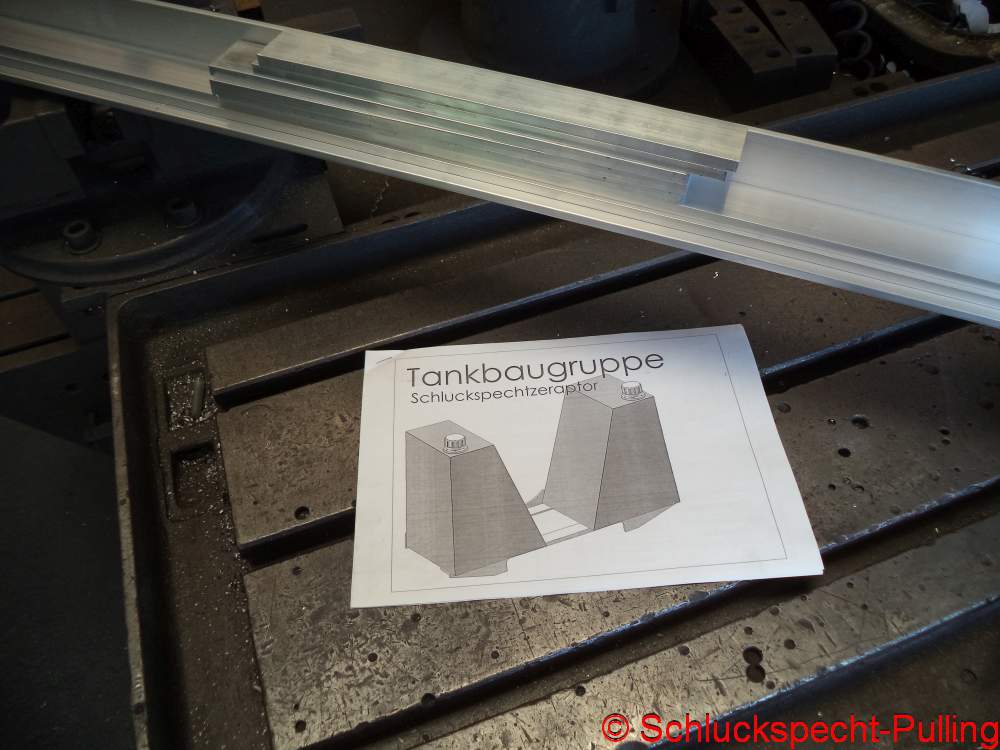 Ja, auch Tanks kann man im CAD konstruieren. Macht auch Sinn wie man später feststellen kann. 😉
Ja, auch Tanks kann man im CAD konstruieren. Macht auch Sinn wie man später feststellen kann. 😉
Yes, tanks can be designed in CAD. Also makes sense as you can see later. 😉
 Aus diesen wüsten Aluzuschnitten….
Aus diesen wüsten Aluzuschnitten….
From these wild cut aluminum blanks …
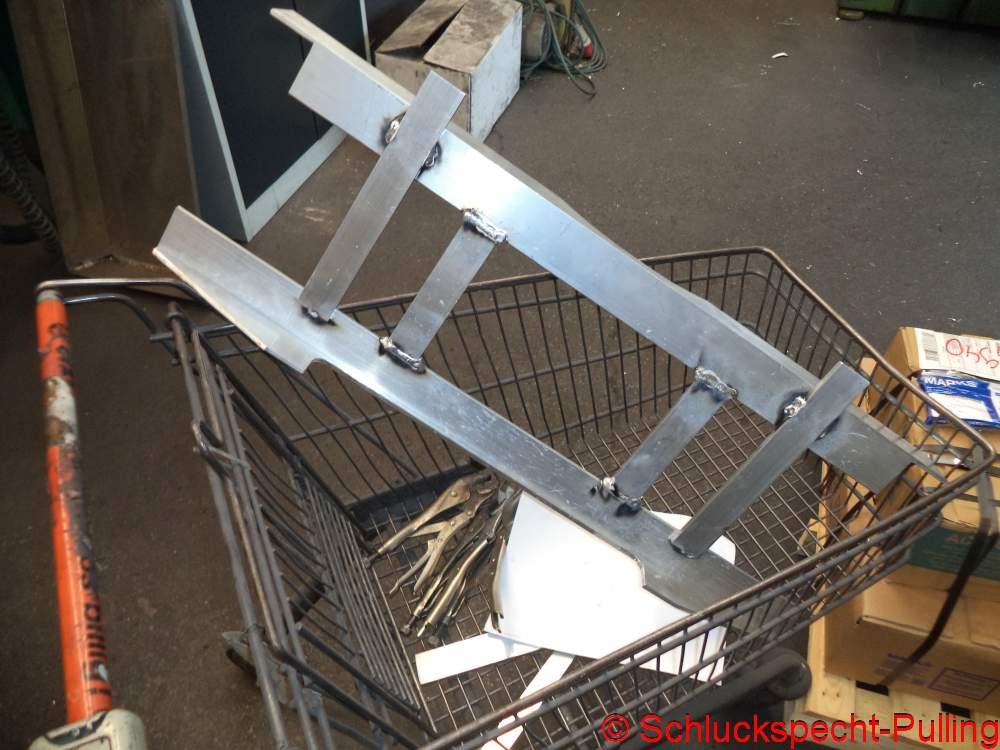 …entsteht ratzfatz der Halterahmen…
…entsteht ratzfatz der Halterahmen…
… the holding frame arises in no time …

 …der nicht nur gut passt, sondern auch noch ganz nett aussieht.
…der nicht nur gut passt, sondern auch noch ganz nett aussieht.
1 zu 0 fürs CAD. 😉
Aus ausgeplotterten Zeichnungen und Pappe…
… that not only fits well, but also looks really nice.
1 to 0 for CAD. 😉
From plotted drawings and cardboard …
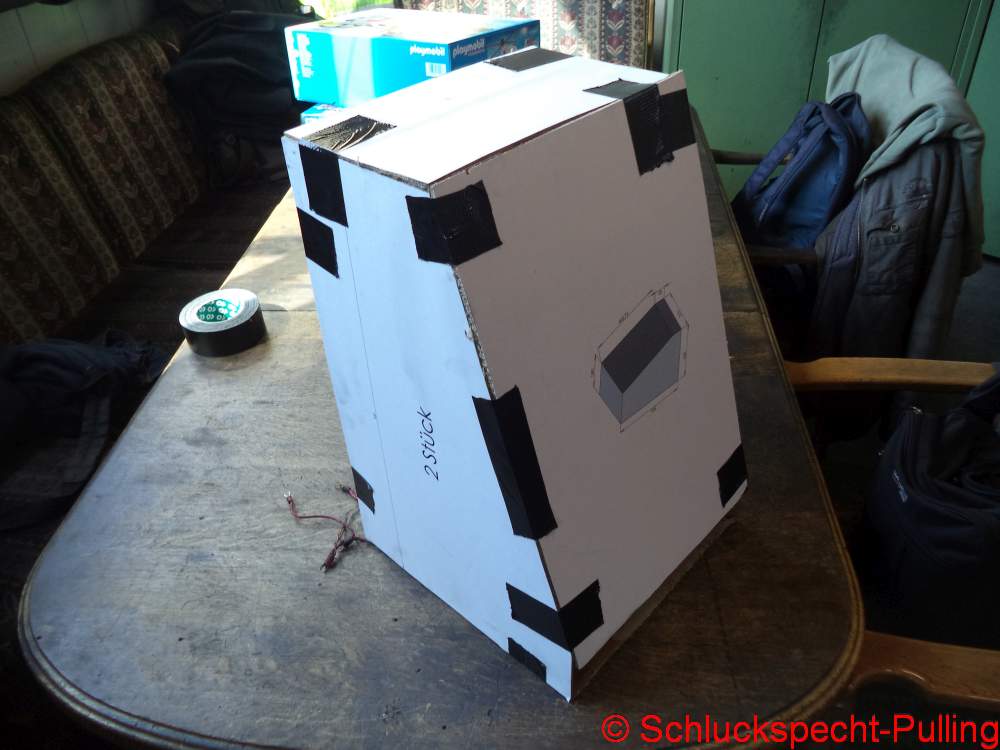 …entsteht ruckizucki ein Modell des Tanks. 2 zu 0 fürs CAD 😉
…entsteht ruckizucki ein Modell des Tanks. 2 zu 0 fürs CAD 😉
… a model of the tank is created in no time. 2 to 0 for CAD 😉

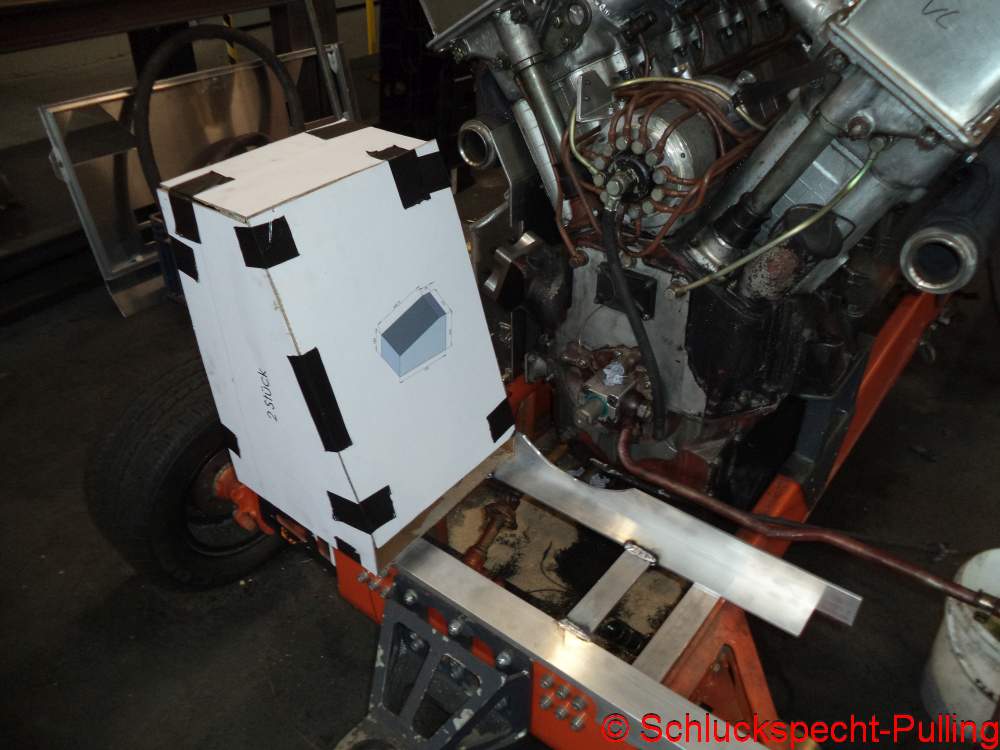
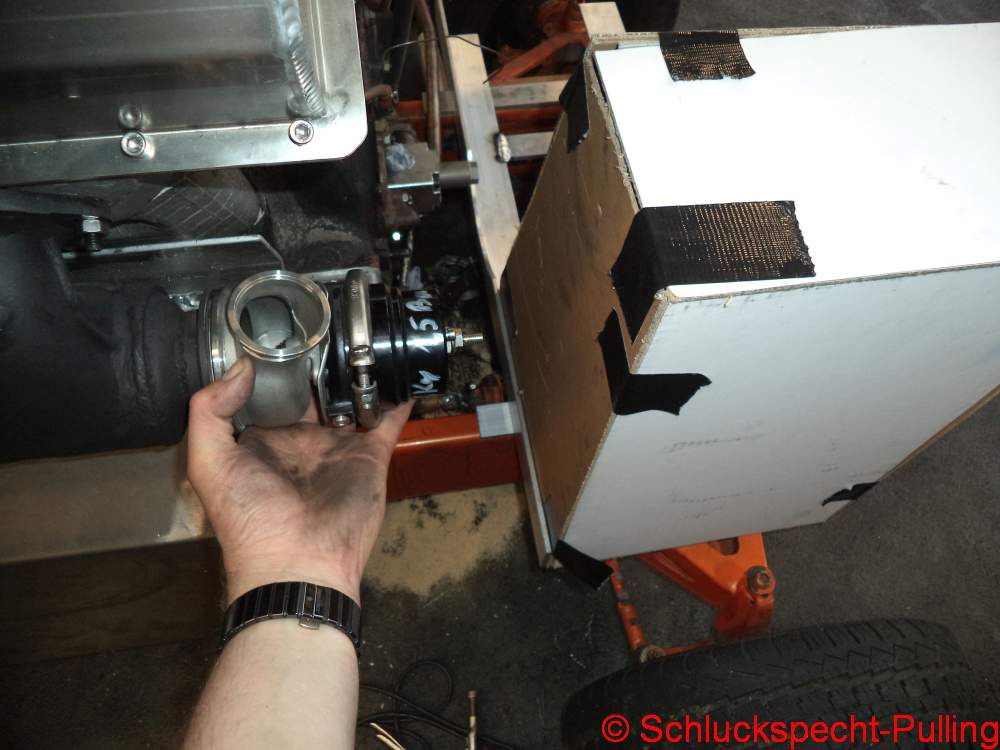 Und sogar das Wastegate passt noch hin 😉
Und sogar das Wastegate passt noch hin 😉
And even the wastegate still fits 😉
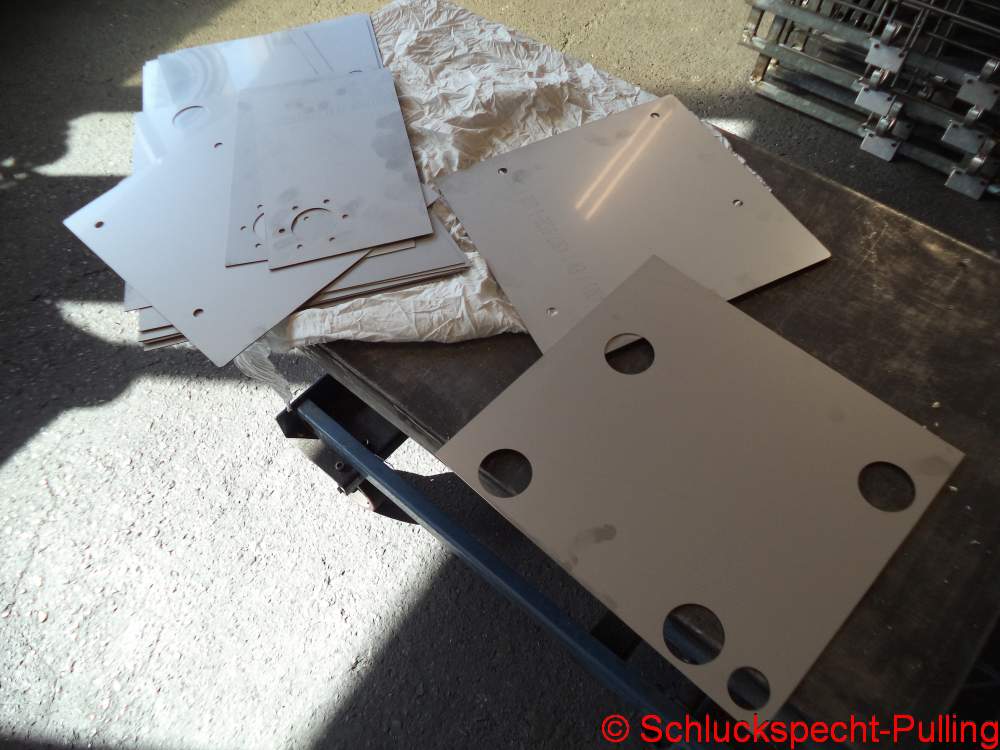 Innerhalb von ein paar Tagen lagen dann auch schon die gelaserte Bleche auf dem Tisch. Danke an dieser Stelle an die Firma WMV Westenfeld!
Innerhalb von ein paar Tagen lagen dann auch schon die gelaserte Bleche auf dem Tisch. Danke an dieser Stelle an die Firma WMV Westenfeld!
Achja, 3 zu 0 fürs CAD 😉
Within a few days, the lasercut metal sheets were already on the table. Thanks at this point to the company WMV Westenfeld!
Oh yes, 3 to 0 for CAD 😉
 Typisch Stefan, artet die ganze Tankgeschichte wieder mal aus….
Typisch Stefan, artet die ganze Tankgeschichte wieder mal aus….
„Häng den bloß nicht starr auf“ haben sieht gesagt. Ok, machen wir. 😉
Typical Stefan, the whole tank story exaggerated again …
„Just don’t hang it up rigidly,“ they said. Ok, let’s do so. 😉
 Nachdem sich dann einige Kilo allerfeinster rostfreier Edelstahl auf der Drehbank in Späne verwandelt hatten…
Nachdem sich dann einige Kilo allerfeinster rostfreier Edelstahl auf der Drehbank in Späne verwandelt hatten…
After a few kilos of the finest stainless steel had turned into chips on the lathe …
 …waren die Aufnahmen für die Metall/Gummielemente auch fertig…. einfach kann ja jeder.
…waren die Aufnahmen für die Metall/Gummielemente auch fertig…. einfach kann ja jeder.
… the brackets for the metal / rubber elements were also ready … anyone can do it easily.
 Schnell noch ein paar Schweißversuche gemacht um die optimale Einstellung zu finden….Ich denke das kann sich soweit schon sehen lassen.
Schnell noch ein paar Schweißversuche gemacht um die optimale Einstellung zu finden….Ich denke das kann sich soweit schon sehen lassen.
An dieser Stelle seien euch die Kanäle von Igor und Manfred Welding ans Herz gelegt. Die hauen ein ganz schönes Knowhow an Schweißtechnik raus.
Quickly made a few more attempts at welding to find the optimal setting … I think that’s pretty impressive.
At this point the channels from Igor and Manfred Welding are recommended to you. They knock out a lot of expertise in welding technology.
 Erstmal ganz harmlos mit den Beschlägen anfangen….
Erstmal ganz harmlos mit den Beschlägen anfangen….
First start quite harmlessly with the fittings …

 …und dann ganz schnell feststellen das sich 1mm Edelstahlblech verzieht wie Sau! *grml*
…und dann ganz schnell feststellen das sich 1mm Edelstahlblech verzieht wie Sau! *grml*
… and then quickly notice that 1mm stainless steel sheet warps like hell! *grml*
 Die Aufnahmen für die Metall/Gummielemente nehmen auch schon Platz.
Die Aufnahmen für die Metall/Gummielemente nehmen auch schon Platz.
The brackets for the metal/rubber elements also are in place.
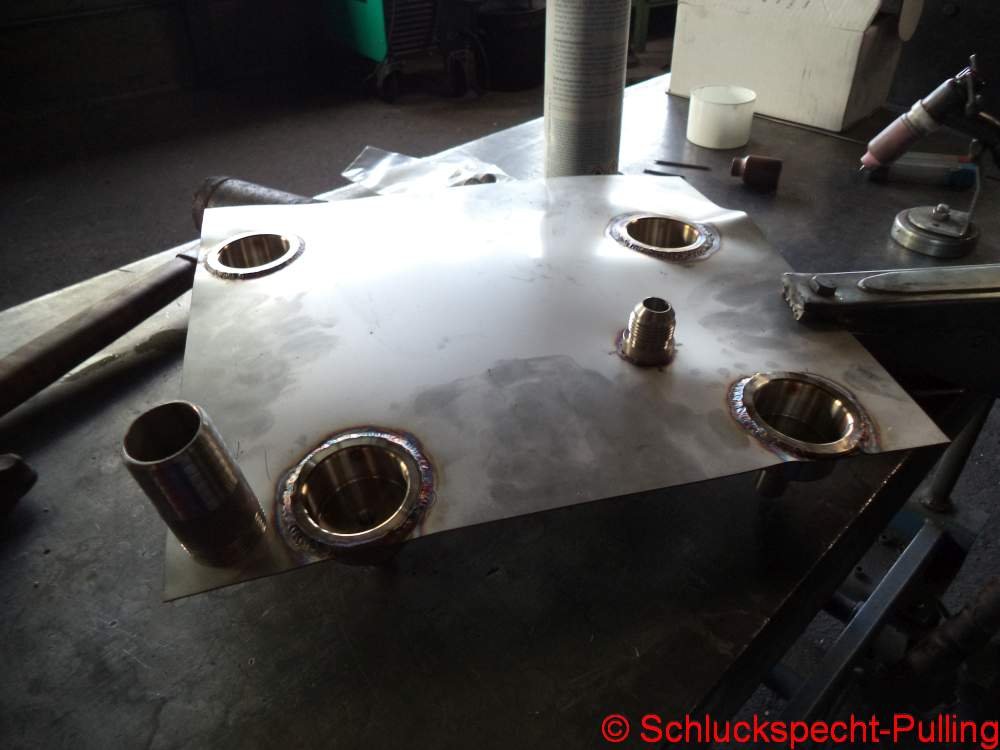
 Soviel dann zum Verzug….Kacke….und es wurde schon mit geringstmöglicher Wärmeeinbringung und immer stückchenweise versetzt geschweißt…. Da muss ich mir wohl mal richtig Spaß mit dem Richthammer machen.
Soviel dann zum Verzug….Kacke….und es wurde schon mit geringstmöglicher Wärmeeinbringung und immer stückchenweise versetzt geschweißt…. Da muss ich mir wohl mal richtig Spaß mit dem Richthammer machen.
Mit dem Tankbau geht es in den nächsten Beiträgen weiter….für heute ist damit erstmal Schluss. Macht aber nichts, wir haben noch Themen 😉
So geil ich den Transmash auch finde, er hat ein paar spezielle Schwachstellen die man kennen muss. Eine davon ist das Schmiersystem. Typisch russisch haben sich es die Konstrukteure einfach gemacht und alle Lagerstellen der Kurbelwelle durch(!) die Kurbelwelle mit Öl versorgt. Normalerweise werden bei einem Motor die Hauptlager aus dem Kurbelgehäuse heraus einzeln mit Drucköl versorgt. Von da geht es dann durch eine recht dünne Bohrung zum jeweiligen Pleuellager.
Die Hubzapfen vom Transmash sind nun genau so großzügig hohlgebohrt wie die Hauptlagerzapfen. Ich hab mal ein Bild gefunden was das deutlich macht.
So much for welding distortion …. shit …. and it was welded with the least possible heat input and always offset in pieces …. I must have fun with the straightening hammer.
The next few posts will continue with tank construction … that’s over for today. But never mind, we still have topics 😉
As cool as I find the Transmash engine is, it has a few special weaknesses that you have to be aware of. One of them is the lubrication system. Typically Russian, the designers have made it easy for themselves and supplied all bearing points of the crankshaft with oil through (!) The crankshaft. Normally, the main bearings of an engine are individually supplied with pressurized oil from the crankcase. From there it goes through a thin hole to the respective connecting rod bearing.
The crank pins of the Transmash are now just as generously hollow as the main bearing pins. I once found a picture that makes it clear.
 Durch die Deckel (Nr. 7) werden diese Löcher nun verschlossen. Untereinander verbunden sind diese „Kammern“ nun durch kleine Löcher. Wenn man jetzt noch bedenkt, dass die ganze Kurbelwelle nur von vorne mit Öl versorgt wird, ist dem ein oder anderen schon klar was das nach langem Stillstand für Probleme mit sich bringt. Richtig, es müssen erst größere Mengen Öl gepumpt werden bevor das hinterste Lager auch nur einen Tropfen sieht. Da sind schnell mal ein paar hundert Umdrehungen auf dem Tacho die furztrocken laufen.
Durch die Deckel (Nr. 7) werden diese Löcher nun verschlossen. Untereinander verbunden sind diese „Kammern“ nun durch kleine Löcher. Wenn man jetzt noch bedenkt, dass die ganze Kurbelwelle nur von vorne mit Öl versorgt wird, ist dem ein oder anderen schon klar was das nach langem Stillstand für Probleme mit sich bringt. Richtig, es müssen erst größere Mengen Öl gepumpt werden bevor das hinterste Lager auch nur einen Tropfen sieht. Da sind schnell mal ein paar hundert Umdrehungen auf dem Tacho die furztrocken laufen.
Jetzt gibt es einige Schlaumeier die das Ölsystem umbauen und dadurch in vielen Fällen eine Verschlimmbesserung bewirken. Es nützt nichts: Es muss Öl vorgepumpt werden.
Das gleiche gilt für den Sprit. Die mechanischen Pumpen sind zwar sehr gut, allerdings dauert es auch hier wieder einige Umdrehungen (die die Pressluftflaschen unaufhaltsam leeren) in denen die Luft aus den Leitungen geschoben werden muss.
Da ich ein rigoroser Verfechter der Gleichteilpolitik bin und die elektrische AEM Spritpumpe schon da lag, brauch ich euch auch hier nicht näher erklären was geschehen ist. 😉 😉 Gut das es davon keine Bilder gibt…… Ich versuch es in Worte zu fassen:
Größere Mengen Getriebeöl (war halt da) flossen auf, über und durch die Pumpe die unter strikter Verweigerung ihrer Mitarbeit beinahe abgebrannt wäre. Hier der Fachartikel dazu. 😉 😉
Damit viel die Gleichteilpolitik für den Themenkomplex „Vorpumpen“ direkt mal hinten runter.
Oh…schon so viel Text…..schnell ein Bild rein…..
These holes are now closed by the cover (No. 7). These „chambers“ are now connected to one another by small holes. If you now consider that the entire crankshaft is only supplied with oil from the front, it is already clear to one or the other what problems this brings with it after a long standstill. Right, larger amounts of oil have to be pumped before the rearmost bearing can see a drop. There are quickly a few hundred revolutions on the speedometer that run dry as a fart.
Now there are some wise guys who rebuild the oil system and thereby in many cases even worsen the situation. It’s no use: Oil has to be pre-pumped.
The same goes for fuel. The mechanical pumps are very good, but here too, it takes a few revolutions (which inexorably empty the compressed starting air ) in which the air has to be pushed out of the lines.
Since I am a rigorous advocate of the common parts policy and the electric AEM fuel pump was already there, I don’t need to explain to you what happened here either. 😉 😉 Good that there are no pictures of it …… I’ll try to put it into words:
Larger amounts of gear oil (it was there) flowed on, over and through the pump, which almost burned down and strictly refused to cooperate. Here is the technical article. 😉 😉
So the common part policy for the topic of „pre-pumping“ was thrown away.
Oh … so much text ….. quickly add a picture …..
 Alex hatte dann die rettende Idee: Die Lobbes hatten doch eine Zahnradpumpe für die Wassereinspritzung. Genau genommen war das eine genau passende Pumpe die eigentlich für das fördern von….Naaaaaa?…..Richtig!….Motoröl gebaut wurde. Manchmal läuft es einfach 😉
Alex hatte dann die rettende Idee: Die Lobbes hatten doch eine Zahnradpumpe für die Wassereinspritzung. Genau genommen war das eine genau passende Pumpe die eigentlich für das fördern von….Naaaaaa?…..Richtig!….Motoröl gebaut wurde. Manchmal läuft es einfach 😉
So, das waren jetzt hunderte Worte dafür das wir eine Pumpe gefunden haben 😉 😉
Wenn wir schon im vorderen Bereich des Treckers am bauen sind….
Alex then had the saving idea: The Lobbes had a gear pump for the water injection. Strictly speaking, it was a perfectly fitting pump that was actually built for pumping …. Guess what? ….. Right! …. engine oil. Sometimes a plan comes together 😉
So, that was now hundreds of words that we have found a pump 😉 😉
If we are already building in the front area of the tractor …
 …fliegt auch gleich die Lenkung raus. Ihr erinnert euch? Die soll hydraulisch werden.
…fliegt auch gleich die Lenkung raus. Ihr erinnert euch? Die soll hydraulisch werden.
… the steering flies out too. You remember? It should be hydraulic.
 Zwei verschweißte Zylinder sollen das Teil von General Motors ersetzen…schauen wir mal.
Zwei verschweißte Zylinder sollen das Teil von General Motors ersetzen…schauen wir mal.
Two welded cylinders are supposed to replace the part from General Motors … let’s see.
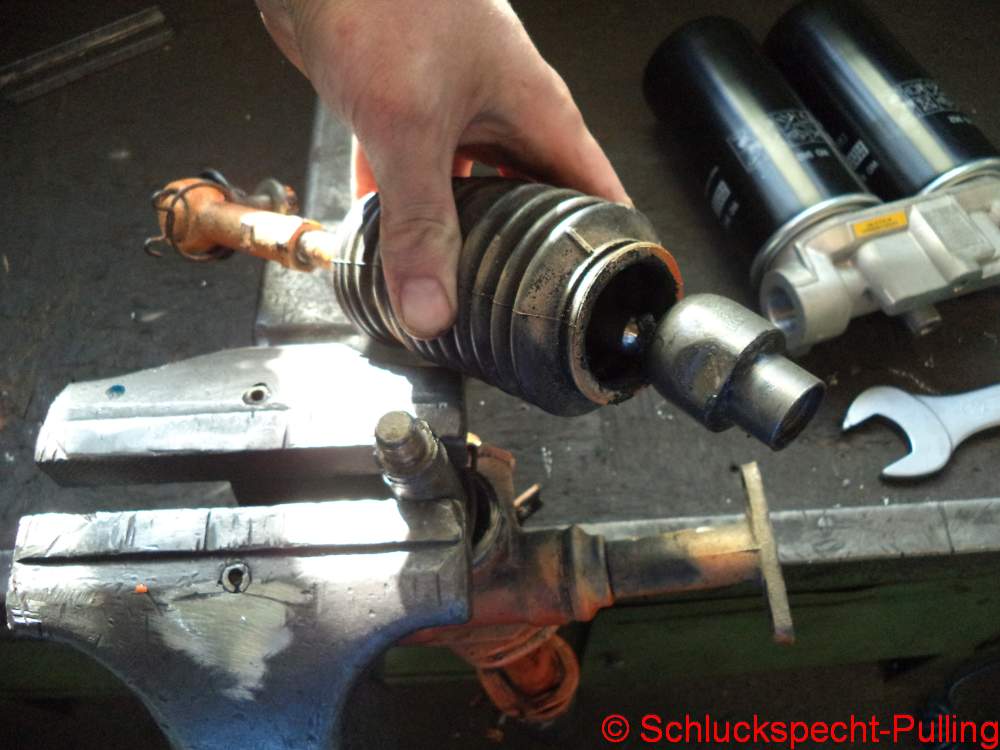
 Die Lenkstangen mit den Kugelköpfen demontieren…
Die Lenkstangen mit den Kugelköpfen demontieren…
Dismantle the steeringbars with the ball heads …
 ..genauso wie die Kolbenstangen der Zylinder.
..genauso wie die Kolbenstangen der Zylinder.
.. as well as the piston rods of the cylinders.
 Nach längerem Messen bin ich tatsächlich zum Schluss gekommen das an dem GM-Teil M14x1,5 geschnitten wurden.
Nach längerem Messen bin ich tatsächlich zum Schluss gekommen das an dem GM-Teil M14x1,5 geschnitten wurden.
After a long measurement, I actually came to the conclusion that M14x1.5 was cut on the GM part.
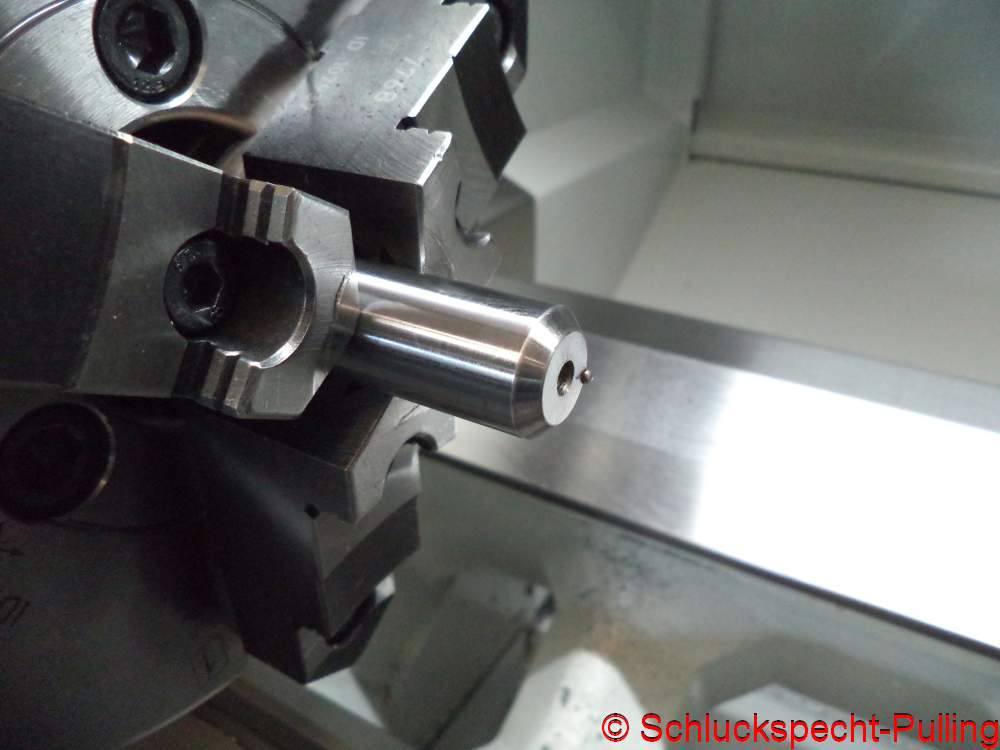 Also die Kolbenstangen rauf auf die Drehbank….
Also die Kolbenstangen rauf auf die Drehbank….
So the piston rods up on the lathe …
… thread turned on …
… and actually ….. M14x1.5
 Zylinder miteinander ordentlich verschweißen.
Zylinder miteinander ordentlich verschweißen.
Weld the ylinder together properly.

 Die angeschweißten Gewindebuchen müssen runter….
Die angeschweißten Gewindebuchen müssen runter….
The welded threaded sockets have to go down …
 …und werden durch andere Schweißfittinge ersetzt. Wichtig an dieser Stelle: Alle(!) Bohrungen im Zylinder müssen später exakt(!) senkrecht nach oben stehen damit man das ganze System entlüften kann.
…und werden durch andere Schweißfittinge ersetzt. Wichtig an dieser Stelle: Alle(!) Bohrungen im Zylinder müssen später exakt(!) senkrecht nach oben stehen damit man das ganze System entlüften kann.
… and are replaced by other weld fittings. Important at this point: All (!) Bores in the cylinder must later be exactly (!) Vertically upwards so that the entire system can be vented.
 Damit ist der größte Teil auch schon erledigt.
Damit ist der größte Teil auch schon erledigt.
With that, most of the work is done.

 Nur noch schnell mal anhalten…sieht gut aus. Fehlt noch eine wichtige Sache ohne die das Ganze nicht funktioniert. Aber auch dazu später mehr. 😉
Nur noch schnell mal anhalten…sieht gut aus. Fehlt noch eine wichtige Sache ohne die das Ganze nicht funktioniert. Aber auch dazu später mehr. 😉
Kommen wir nun zum Themenkomplex „Was die können, das können wir schon lange!“ 😉
Der ein oder andere hat es mitbekommen, ein etwas bekannterer Sportwagenbauer aus Zuffenhausen setzt zum ersten mal 3D-gedruckte Kolben in einem Serienmotor ein.
Das kann der Stefan nicht auf sich sitzen lassen. SCHMEISST DEN DRUCKER AN!!!!
Just hold it in place… looks good. There is still one important thing missing without which the whole thing would not work. But more on that later. 😉
Now we come to the complex of topics „What they can do, we can do it for a long time!“ 😉
One or the other noticed that a somewhat better-known sports car manufacturer from Zuffenhausen is using 3D-printed pistons in a series engine for the first time.
Stefan can’t let that sit on him. SWITCH ON THE PRINTER !!!!
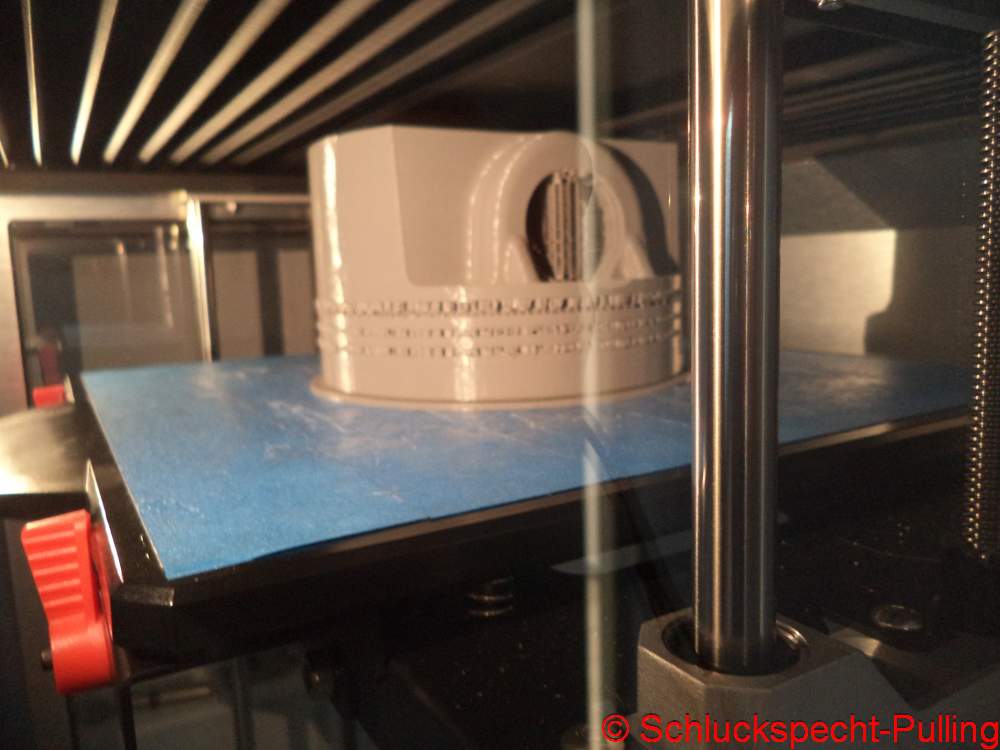
 So entsteht in etwas mehr als 20 Stunden….
So entsteht in etwas mehr als 20 Stunden….
This creates in just over 20 hours …




…ein Ottomotorkolben für einen russischen Panzermotor. Naja gut, einschränkend muss man sagen das es nur ein Kolben für einen 12 Zylinder ist und die Temperaturfestigkeit des verwendeten Kunststoffs reicht nicht so ganz an die von Aluminium heran, aber ein Anfang ist gemacht 😉
Um ein wenig Licht ins Dunkel zu bringen: Der Kolben soll irgendwann mal aus Aluminium gemacht werden. Langfristige Aufgabe ist die Behebung von zwei weiteren Schwachstellen des Transmash. Zum einen die innere Wuchtung des Kurbeltriebs. Die ist einfach nicht vorhanden. Für einem V12 der Serienmäßig 1.800 1/min dreht nicht weiter tragisch. Geht man Richtung 4.000 zerstört es im besten Fall nur die Hauptlager und im schlimmsten Fall bricht der Block auseinander. Ziel muss es daher sein die bewegten Massen im Kurbeltrieb runter zu bekommen und dann mit geeigneten Gegengewichten bestmöglich auszugleichen. Der (geschmiedete!!!) Dieselkolben im Motor ist schon extrem geil gemacht. Für einen Dieselkolben. So wie der obige Kolben sieht Stefans Idealvorstellung für einen entsprechenden Ottokolben aus.
Zweite Schwachstelle sind die Kolbenringe. Der Dieselkolben ist mit ganzen fünf(!) Kolbenringen bestückt. Augenscheinlich alle gleich. Auch hier ist das für einen Dieselmotor der allenfalls mal einen leichten Unterdruck im Zylinder hat kein Thema. Im Drosselbetrieb eines Ottomotors herrscht dort schnell mal ein Vakuum von -0,6Bar. Das zieht einem bei unzureichender Ölabstreifung selbiges in großen Mengen bis in den Brennraum. Da hat es aber mal so gar nichts verloren. Aus diesem Grunde sollen direkt richtige Ölabstreifringe verbaut werden.
Das ist allerdings alles noch Zukunftsmusik.
In diesem Sinne: Bleibt gesund und bleibt dran!!!
… a ottocycle piston for a russian tank engine. Well, one must say that it is only a piston for a 12 cylinder and the temperature resistance of the plastic used does not quite reach that of aluminum, but a start has been made 😉
To shed some light on the darkness: The piston should one day be made of aluminum. The long-term task is to fix two further weak points in the Transmash. On the one hand there is the internal balancing of the crank mechanism. It just doesn’t exist. For a V12 with the standard 1,800 rpm, it is no longer tragic. If you go towards 4,000, in the best case scenario it will only destroy the main bearings and in the worst case the block will break apart. The aim must therefore be to get the moving masses in the crank drive down and then to balance them out with suitable counterweights. The (forged !!!) diesel piston in the engine is extremely awesome. For a diesel piston. Stefan’s ideal for a corresponding ottocycle piston looks like the piston above.
The second weak point are the piston rings. The diesel piston is equipped with five (!) Piston rings. Apparently all the same. Again, this is not an issue for a diesel engine that has at most a slight negative pressure in the cylinder. In throttle operation of a gasoline engine, there is quickly a vacuum of -0.6 bar. If the oil scraping is inadequate, this pulls the same in large quantities into the combustion chamber. But there it defenetivly it should not be. For this reason, correct oil control rings should be installed directly.
However, all of this is still a long way off.
In this sense: stay healthy and stay tuned!
 10936total visits,1visits today
10936total visits,1visits today


